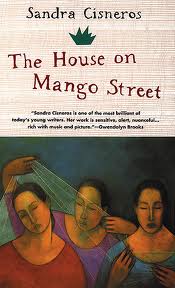The House on Mango Street by Sandra Cisneros
Reviewed by Karen

Ratings Explanation
Language: Hell is used as a place. The Lord’s name taken in vain once.
Violence: Abusive fathers or husbands are mentioned. Those who aren’t Latino fear being knifed in the neighborhood.
Sexual Content: Sexual situations are mentioned or alluded to on many occasions, but the author only provides sketchy details. Esperanza’s neighbors and peers exchange lustful looks towards each other, girls dance – vying for boys’ attention, hookers are hired (alluded to), teens slink off to the alleys together, Esperanza is raped at an amusement park.
Adult Content: Esperanza has her fortune told. She deals with poverty, death, and machismo attitudes. She feels trapped in her environment and wishes to escape. She notices others on Mango Street dealing with abuse, teen pregnancy, abandonment, smoking, drinking, lecherous old men, stealing cars/joyriding and subsequent arrest. Sally uses attention from boys as an escape from her abusive father.
Synopsis
Esperanza is a young teen growing up in a Hispanic, inner-city Chicago neighborhood. Her large family has previously lived in slum apartments, so, although it is not the ideal home of Esperanza’s dreams, it is an improvement. Throughout the year, Esperanza matures from a girl whose focus is on playing with friends to a young woman who notices her physical and emotional changes, experiences her first crush and first job, and then is sexually assaulted. Esperanza writes observations about her life, and the lives of others in her community on Mango Street to help her make sense of what she sees happening. She notices and experiences suffocating social influences and expectations. The metaphor of feeling like a tree trying to grow in cement tells the reader that Esperanza feels trapped and wishes for a life of freedom and independence. Esperanza looks toward other women in her community as role models, but sees only entrapment, male-domination and disappointment. Esperanza, a composite of many Hispanic women, longs to leave, but knows Mango Street (her culture) will always be a part of her.
This coming-of-age book is required reading for many high school English students. I was disappointed in this choice. The book, however, does lend itself to topics for classroom discussion and a myriad of writing prompts. I am guessing this is why English teachers choose this book. (Also, the book is an easy and quick read.) The book offers a realistic, but depressing, view of poverty-stricken subcultures in America. I am glad that the main character, Esperanza, longs to be free of the economic environment that she is born into. She vows to escape from the Latina social mores and poverty. The author explains that each of the short chapters is an individual story (vignette) that can be read stand-alone or “that could be read all together to tell one big story, each story contributing to the whole—like beads in a necklace.” This was a unique and interesting style of writing.









